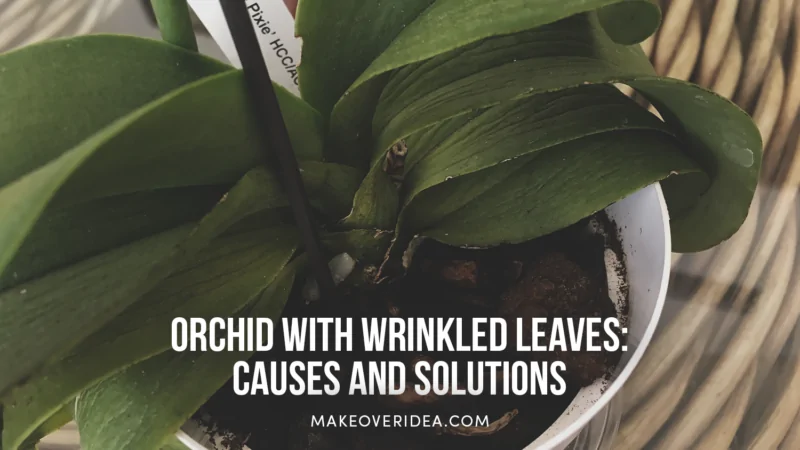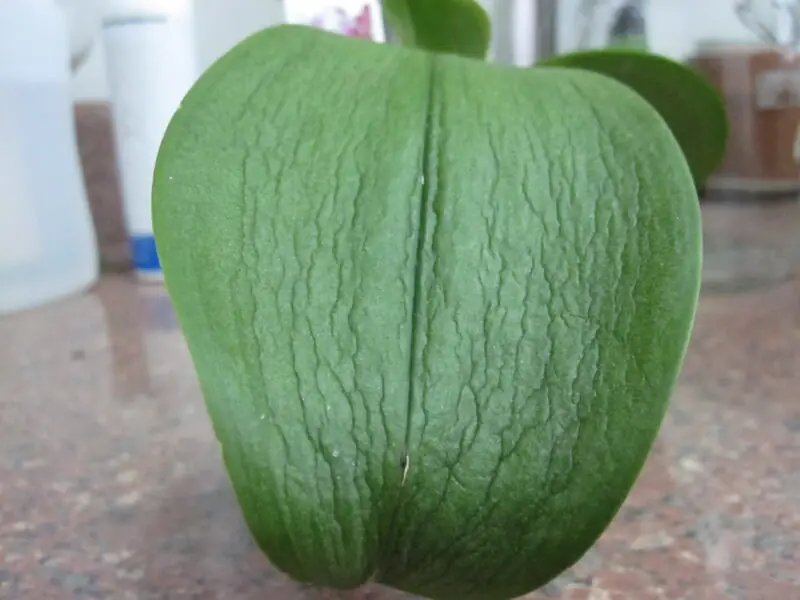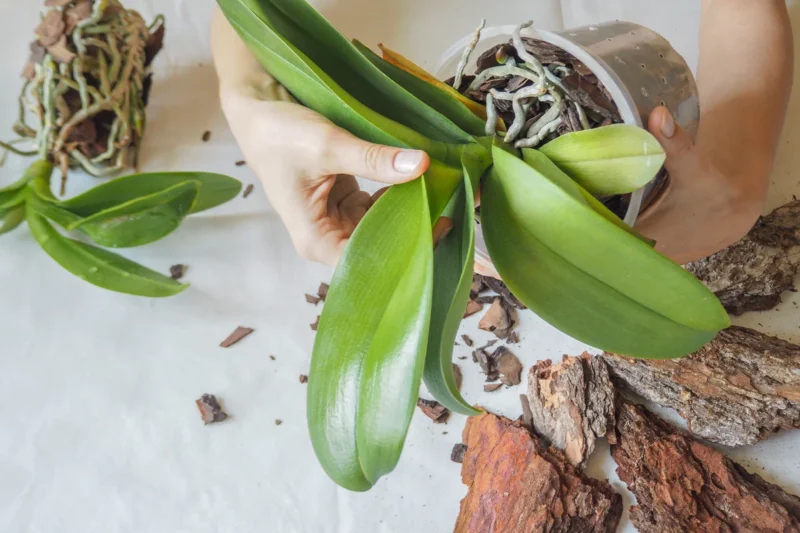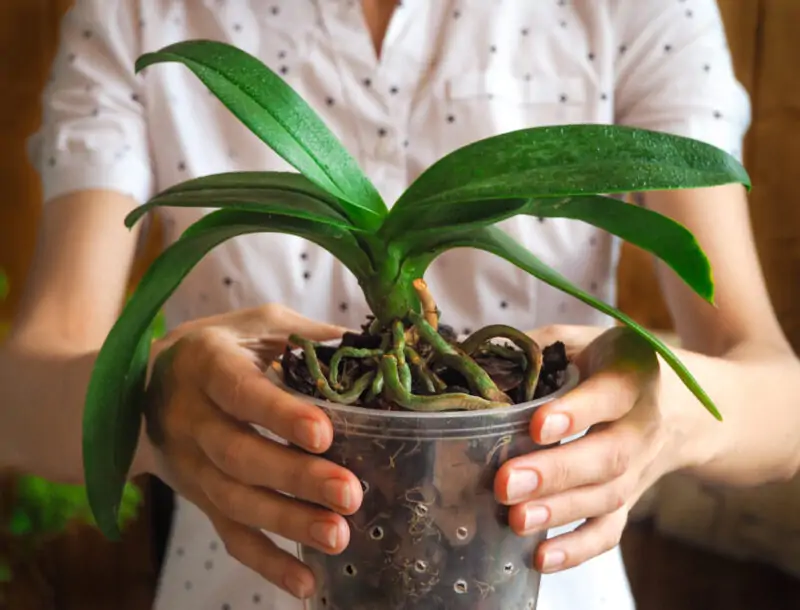Orchid with Wrinkled Leaves: A Limp Orchid Leaf Common Causes and Solutions

Orchids are a widespread and diverse family of flowering plants admired for their striking beauty and exotic appeal. However, caring for these delicate plants can sometimes prove challenging, especially when faced with the common issue of an orchid with wrinkled leaves. In this article, we’ll explore the reasons behind wrinkled orchid leaves and offer tips and solutions to help you maintain a healthy and vibrant plant.
Understanding Orchids with Leaves That Wrinkle and Limp
Orchid leaves can become wrinkled for various reasons, ranging from environmental factors to issues with the plant’s roots. To effectively address the problem, it’s essential to understand the root causes and identify the specific type of wrinkling your orchid is experiencing.
Typical Reasons for Orchid Leaves Wrinkling
Orchid green leaves with wrinkles can be caused by several factors. Let’s explain each common cause:
- Underwatering: Because orchids need a precise balance of moisture, submerging them can cause dryness and wrinkled leaves. Maintain a regular watering schedule and keep an eye on your plant’s moisture levels.
- Overwatering: Overwatering your orchid can be equally as detrimental as underwatering, leading to root rot and oxygen deprivation in the plant. A need to modify your watering schedule might be seen in limp and wrinkled leaves caused by overwatering.
- Low humidity: Because orchids like wet conditions, low humidity can cause the plant tissue to dehydrate and wrinkle. For your orchid, the proper moisture levels can be maintained with the aid of a humidifier or tray with water.
- Improper potting mix: Orchids need well-draining mixes, and a flawed orchid potting mix can cause root issues, which eventually result in wrinkled leaves. Make sure your orchid is planted in an appropriate medium, such as pieces of coconut husk or a bark-based mix.
Why Are My Orchid Leaves Creased and Limp
The appearance of wrinkled, limp, and droopy leaves is typically an indicator of a root-related problem. The upper parts of the orchid may shrivel very often when the root system is damaged. A frequent offender is overwatering, which results in root rot and deprives the plant of vital nutrients and oxygen. Check the signs of rotted roots, such as brown, mushy, or foul-smelling roots, if you suspect overwatering, and change your watering schedule appropriately.

Identifying Specific Problems: Why a Healthy Orchid Leaf Gets Limp
Various leaf issues can affect orchids, each with its unique symptoms and treatment requirements. Accurate diagnosis is critical to addressing the problem of why healthy orchid leaf shriveled and restoring your plant’s health.
Orchid Leaves Wrinkled and Yellow: Diagnosis and Treatment
Yellowing, creased leaves on an orchid can indicate several issues, including:
- Nutrient deficiency: A lack of essential nutrients, such as nitrogen, can cause leaves to turn yellow and wrinkle. Regularly fertilize your orchid with a balanced fertilizer to ensure it receives the necessary nutrients.
- Natural aging: Older leaves may naturally yellow and wrinkle before eventually falling off. As long as new leaves continue to grow, this is a normal part of the orchid’s life cycle.
- Overwatering: To get enough water does not mean pouring the plant over the edge. As mentioned earlier, overwatering can lead to root rot because of common orchid fungus and oxygen deprivation that lead to yellow and limp leaves. Adjust your watering schedule and ensure proper drainage under the orchid mix to address this issue.
Orchid Leaves Get Wrinkled, Leathery, and Soft: What to Do
Leathery, soft, and wrinkled orchid leaves can be a sign of underwatering or low humidity. To remedy this, take the following steps:
- Check your watering schedule: Ensure you’re providing your orchid with enough water and adjust your routine if much water is necessary.
- Monitor humidity: Maintain proper levels for your orchid by using a humidifier or tray with water or misting the plant regularly. Aim for a humidity level of around 40-60% for most orchid species.
- Inspect the root system: Healthy orchid roots should be firm and white or green. If you notice mushy, discolored, or rotten roots, it could indicate a more severe issue that requires repotting and trimming damaged roots.
- Reassess your potting mix: Make sure your orchid is planted in a well-draining, high-quality potting mix, and repot your orchid if necessary.
By carefully monitoring your orchid’s environment, watering routine, and overall health, you can address the issue of creased leaves and ensure your plant thrives. Remember that each orchid species may have unique care requirements, so be sure to research the specific needs of your particular orchid for the best results.
How to Fix Wrinkled Orchid Leaves: Getting Healthy Orchid
Proper care is crucial for addressing and preventing wrinkled leaves in orchids. Implementing best practices and knowing how to fix creased leaves can help you maintain a healthy, vibrant plant.

Tips for Caring for Wrinkled Leaves on Orchids
Use these best practices to keep your orchid wrinkle-free and in good health:
- Avoid watering problem: Consider parameters like the potting material, humidity, and temperature to find the ideal balance for your orchid’s watering requirements.
- Maintain humidity: Since orchids prefer moist conditions, maintain a relative moisture of between 40 and 60 percent. To keep the right levels, use a humidifier, misting, or special tray that makes up for the lack of water.
- Regularly fertilize: Give your orchid the nutrition it needs by applying a balanced orchid fertilizer regularly.
- Choose the proper potting mix: Employ a potting mixture that is high-quality, well-draining, and suited for orchids, such as one based on bark or coconut husk chips.
- Ensure enough air movement: The health of orchids depends on effective air movement. Avoid overcrowding and place your orchid in a well-ventilated environment.
A Step-by-Step Guide for Removing Wrinkled Leaves
To restore wrinkly orchid leaves, take the following actions:
- Diagnose the problem: Identify the cause of the wrinkling, such as underwatering, overwatering, or low humidity.
- Address the root cause: Make the necessary adjustments to your care routine, such as changing your watering schedule, increasing moisture, or repotting with a better potting media.
- Trim-damaged roots: If you suspect root issues, gently remove the orchid from its pot and trim away any damaged, mushy, or discolored roots of your orchid.
- Repot if necessary: If your orchid’s potting mix is the issue, repot your orchid in fresh, well-draining medium.
- Monitor and adjust: Keep a close eye on your orchid’s progress and continue to make adjustments as needed to ensure a full recovery.

Can Wrinkled Orchid Leaves Recover: Signs and Tips
Yes, wrinkled orchid leaves can recover if the issue is addressed promptly and correctly. Signs of recovery include:
- New leaf growth: The appearance of new leaves indicates that your orchid is recovering and regaining its health.
- Root improvement: Healthy roots are a sign that your orchid is on the mend. Look for firm, white, or green roots as a positive indication.
- Leaf texture improvement: Creased leaves may begin to regain their normal texture, appearing less wrinkled and more firm.
To aid in recovery, follow the best practices for orchid care and monitor your plant closely, making adjustments as needed.
Can an Orchid Survive Without Leaves: Understanding Orchid Resilience
Orchids are resilient plants and, in some cases, can survive without leaves for a short period. However, this is not ideal, as leaves are essential for photosynthesis and overall plant health. It’s crucial to address any issues causing leaf loss promptly and provide your orchid with the proper care to encourage new leaf growth and overall recovery.
FAQs on Orchid Leaves
Orchid enthusiasts often have questions about the health and care of their plants, particularly when it comes to creased leaves. Here, we address some frequently asked questions to help you better understand and water your orchid. Your plants won’t wilt — we’ll help you!
Wrinkled orchid leaves can be caused by various factors, including underwatering, overwatering, low moisture, poor-quality potting mix, or root issues. Identifying the root cause and making appropriate adjustments to your care routine can help address the problem.
Several factors can cause wrinkled orchid leaves:
Underwatering, leading to dehydration
Overwatering, causing root rot and oxygen deprivation
Low humidity, resulting in moisture loss from plant tissue
Poor quality potting mix, leading to root problems
By addressing these issues, you can prevent and treat creased leaves on your orchid.
Wrinkled and drooping orchid leaves can be a sign of root-related issues, often caused by overwatering. To address this problem:
Check your watering routine and ensure proper drainage.
Inspect the roots for signs of rot, such as brown, mushy, or foul-smelling roots.
Trim any damaged roots and repot the plant in fresh, well-draining potting mix if necessary.
Continuously monitor your orchid’s progress and make adjustments to its care as needed.
Conclusion
Caring for an orchid with wrinkled leaves can be challenging, but with the proper understanding of orchids grown as houseplants, your plant can recover and thrive to the envy of all orchid growers. By diagnosing the root cause of wrinkling, implementing best practices, and addressing specific leaf issues, you can ensure healthy leaves and the longevity of your orchid. Remember, each orchid species may have unique care requirements, so be sure to research the specific needs of your particular orchid blooms for the best results.